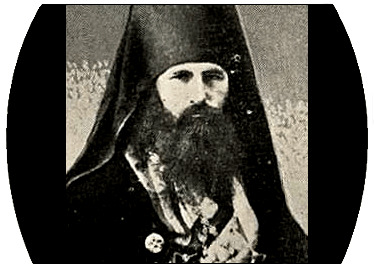Vasily Grigorievich Sokolovsky-Avtonomov was born on December 31, 1852 into the family of a priest in the village of Senkovka in the Poltava Province of Russia. After completing his studies at the Poltava Seminary, he enrolled at the Kazan Theological Academy. Upon graduation, he was appointed on July 26, 1878 as assistant supervisor of the Poltava Ecclesiastical School. On September 29, 1878, he was tonsured a monk with the name Vladimir, ordained to the diaconate on October 1, and to the priesthood on October 3 of that same year. Early in the following year, on January 14, 1879, Fr. Vladimir was assigned to serve within the Japanese Orthodox Mission as an assistant to St. Nicholas Kasatkin, Enlightener of Japan. Awarded the rank of igumen in 1884, he was appointed to the faculty of the Kholm Seminary on June 9, 1886.
Just over a year later, on August 13, 1887, he was raised to the rank of archimandrite and assigned to the position of inspector (dean of students) at the same seminary. Following his consecration to the episcopacy in Saint Petersburg on December 20, 1887 and assignment as ruling hierarch of the Aleutians and Alaska, Bishop Vladimir arrived in San Francisco in March 1888. In his episcopal entourage were eighteen students eager to assist in the work of the mission along with five of Bishop Vladimir’s coworkers at the Kholm Seminary. With his arrival in North America, the diocese once again had a resident ruling bishop, thus ending the six-year period of its administration from Saint Petersburg.
Bishop Vladimir was a highly cultured person, particularly gifted in linguistics and music. With his knowledge of languages and his musicianship, Bishop Vladimir was able to produce musical settings for his English translations of liturgical texts, which were then sung by the San Francisco Cathedral choir during services. Additionally, Father Sebastian Dabovich was assigned to preach in English at the Cathedral. Moreover, Bishop Vladimir loved great solemnity in the celebration of liturgical services and thus served in an extraordinarily ceremonial manner. These embellishments of liturgical life had a great impact and attracted many people to church attendance, which necessitated the construction of a new, larger cathedral in San Francisco.
Bishop Vladimir also traveled tirelessly throughout the United States in fulfillment of his archpastoral service. In his brief episcopal tenure in America, he crisscrossed the country several times. During this period, Greek-Catholic Slavic immigrants arrived in America from Austro-Hungary and, led by St. Alexis Toth, began their return to Orthodoxy from Uniatism. On March 25, 1891, Bishop Vladimir received St. Alexis and his parishioners in Minneapolis, Minnesota into the bosom of the Orthodox Church.
Because of a troublesome situation unfolding in San Francisco, Bishop Vladimir’s service in America was cut short. Effective June 8, 1891, he was assigned as Bishop of Ostrogozhsk, auxiliary of the Voronezh Diocese. In October of that year he left America to assume his new position.
He subsequently served as the ruling hierarch of two dioceses: initially in Orenburg and the Urals (from December 22, 1896), and later in Yekaterinburg and Irbit (as of November 26, 1903).
On March 18, 1910, Bishop Vladimir was granted retirement from episcopal responsibilities due to illness, but was appointed abbot of the Andronikov Monastery in Moscow.
In 1921, he was raised to the rank of Archbishop and appointed to rule the Diocese of Yekaterinoslav (today: Dnipropetrovsk, Ukraine) by Patriarch Tikhon. However, due to continuing turmoil after the Russian Revolution of 1917, he was unable to take up his responsibilities there and remained in Moscow. In 1926, he was briefly affiliated with the Gregorian schism in the Russian Church, but soon repented and returned to the canonical church.
While enduring isolation and utter poverty, Archbishop Vladimir reposed in the Lord on November 27, 1931. He was buried next to the altar of All Saints Church, where he had been serving. This church was then located in the suburbs of Moscow but is now within the city limits.
Everywhere he labored, he always sought to elevate the quality of liturgical singing. His published works focus largely on refuting Roman Catholic teachings and missionary activities, particularly in Japan.
In America, Bishop Vladimir was primarily known for his cultural refinement and musical accomplishments, while later in Moscow, he was esteemed as an ascetic spiritual elder.
There is an interesting and particularly poignant published account of a fleeting encounter Archbishop Vladimir had with Saint Patriarch Tikhon, which was doubtless moving for both of them, as it occurred in the midst of severe church persecution and on the verge of the final sufferings both hierarchs were about to endure. It took place at a difficult time in 1922 in a Moscow church, which was already slated to be handed over to the schismatic “Living Church” by the government. Patriarch Tikhon had come there to serve the Liturgy for the last time, and Archbishop Vladimir also happened to be present at that service.

